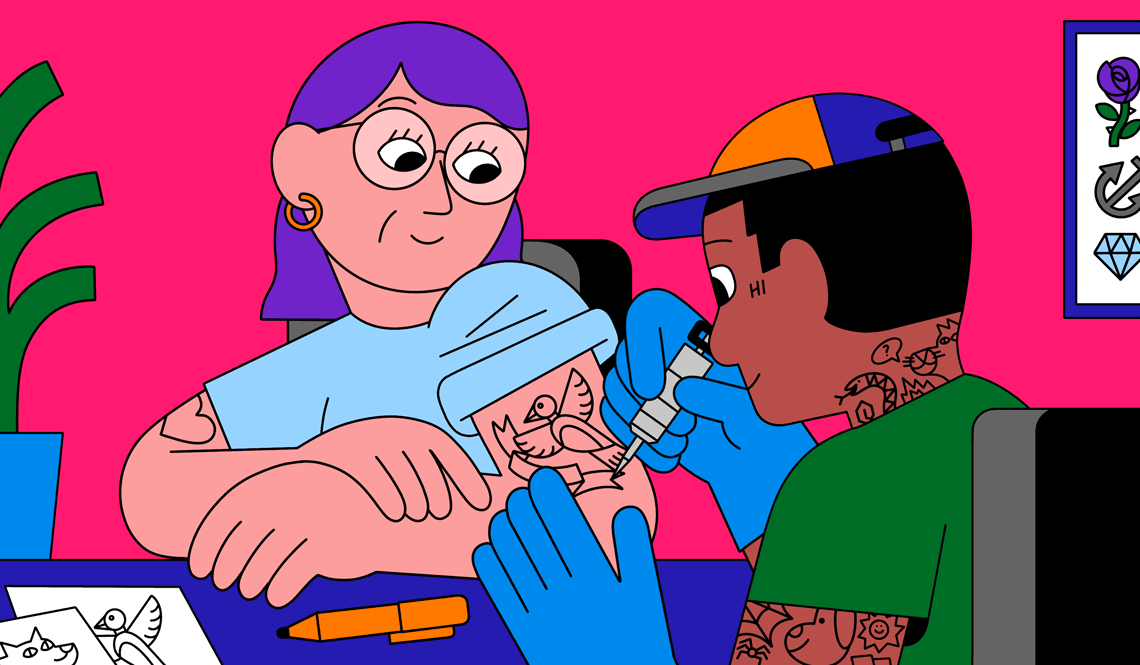AARP Hearing Center


A 94-year-old man came into Shawn Conn’s tattoo parlor in Rochester, N.Y., to get a tattoo to honor his late wife. He’d always wanted one, but she wasn’t a fan.
“He waited over 70 years to get his first tattoo because his wife didn’t like them,” Conn recalls. “He had me tattoo a small rose on him because that was her name.” He came in the following summer to get a tattoo for himself — an eagle head for his time in the service.


AARP Membership— $12 for your first year when you sign up for Automatic Renewal
Get instant access to members-only products and hundreds of discounts, a free second membership, and a subscription to AARP the Magazine.
Tattoos seem to be no big deal these days – even among those 50+. One-quarter of adults ages 50 to 64 are tatted up, according to a 2023 Pew Research Center survey. And most people get them for the same reason as Conn’s 94-year-old customer: to honor a meaningful person or time in their life.
But getting a tattoo as a 50+ adult is a bit different than getting one in your younger years. Here’s what you need to know before you head into the tattoo parlor.
The skin you’re in


Andie Corby got her tattoo at 75, even though she had told friends in the past that she’d only do it if hell froze over. Then, in 2021, her 48-year-old son, Jason, unexpectedly passed.
To honor Jason, Corby decided to get a tattoo similar to the one Jason had — the cartoon character Chilly Willy holding a mug of beer, saying, “It just seemed like the right thing to do.”
Smaller than her son’s had been, Corby’s tattoo is without the mug of beer and includes Chilly Willy holding a butterfly, which she added as an homage to her mother, who also has passed.
“Most people my age say, ‘I would never do that,’ [but] my grandchildren think it’s really cool,” she says.
Long lost collagen. Tattoo ink is placed into the middle layer of skin, the dermis. It’s “rigid and robust with abundant collagen” when we’re born; but as we age, we lose collagen and our skin becomes more elastic and wrinkles, says Matthew J. Mahlberg, M.D., a board-certified dermatologist at the Colorado Center for Dermatology & Skin Surgery in Denver.
That’s why when getting a tattoo as an older adult, says Mahlberg, go for those parts of the body that stay thickest and firmest, such as your shoulder, back or abdomen. Tattoos in thinner skin areas, such as the forearm, tend to lose their vibrancy and become blurrier.
Too much fun in the sun. And if you have had lots of sun exposure, maybe keep your tatted area to places where the sun doesn’t shine, says Conn, who likens tattooing a sun-damaged area to tattooing a leather handbag. “Your natural pigment kind of overtakes the ink.”
The ouch factor. It seems to hurt more for those with thin skin, says Conn. “It’s not a painless process, which is part of why it’s such an exclusive club as far as people having tattoos,” he says. “They earn them. [And] in my 30-plus years of tattooing, I have noticed a lot of my clients who have been with me through the years complain that it gets more painful as they age. I myself have also noticed that.”
Coloring an area, which requires going over the same spot repeatedly, will be more painful than an outline, he adds.































































More From AARP
Skin Care Tips As You Age
Everything you need to know about how to get glowing skin, plus mistakes to avoid8 Major Health Risks for People 50 and Older
A look at the top killers — and how to dodge themSkip the Scams: Skin Care That Really Works
Products and solutions that make a differenceRecommended for You